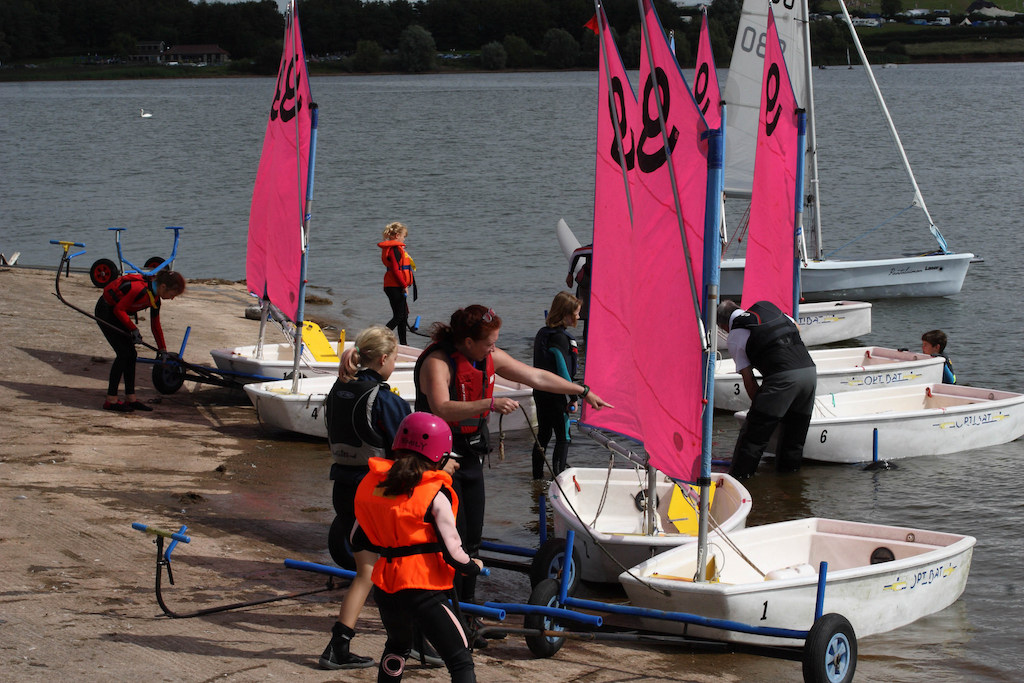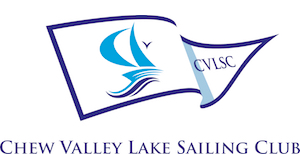Buying a Youth Dinghy
 Do I need my own boat? What kind of dinghies do the young sailors use?
Do I need my own boat? What kind of dinghies do the young sailors use?
All of our organised youth training courses are carried out in dinghies appropriate to the young sailor and to the conditions, in a range of CVLSC owned Optibats, Toppers, RS Teras, RS Fevas, RS Quests or Laser Pico dinghies. If you have one of these dinghies of your own, then your young sailor may be able to use it during our organised courses, but you should contact us to discuss this and will need to complete forms to authorise such use (such as committing required levels of insurance are in place and disclaiming liability for damage etc.)
Young sailors who are CVLSC members may be able to use club dinghies at other times when they are not in use on club courses and when the lake is open. Hire fees may be relevant depending on the age of the sailor and the dinghy they would like to use (see here). You can arrange such use and make payment to the club’s Duty Officer on the day.
We would actively encourage you to consider young sailors getting their own boats as they progress with this brilliant sport, so that they can start to sail more regularly and get more involved in the Club sailing and racing. There are a wide range of classes sailed by current youth as part of the club racing programme, including Toppers, ILCAS and 29ers – see the class specific youth pages for more details. More information about buying your own boats is set out below.
 What dinghy should my young sailor sail?
What dinghy should my young sailor sail?
The dinghies used on our various courses and training sessions are explained above and on our other youth pages. Parents (and sailors) often want to know which boat their young sailors should be sailing as they progress, and perhaps when they consider buying their own dinghies.
The Youth Team are happy to discuss potential options for your young sailor. In very basic terms, sailors should be in the weight range of the boat, and at the correct skill level, to have the greatest chance of success and, most importantly, fun.
 I would like to buy a boat for my child – what should I think about?
I would like to buy a boat for my child – what should I think about?
The dinghies used on our various courses and training sessions are explained above and on our other youth pages.
If you would like to buy your own dinghy, we would often advise getting the sort of boat your child has been happiest sailing and tried at the club/ on our youth courses (see above). You may also be keen to consider what their friends are sailing, as our own parent experience shows that both the young sailors and their parents often enjoy it more when in good company.
The first thing to remember with first boats for a young sailor, is that you really don’t need to buy a new one! And you can usually sell a second hand boat when it’s been outgrown for pretty much what you might have bought it for. It is unlikely to be an investment when you take wear and tear into account, but hopefully it shouldn’t depreciate too much.
At CVLSC a Topper is often bought as a first boat. They are readily available and can usually be picked up for a very reasonable price at CVLSC or beyond. They usually come with the (standard) 5.8m sail, but some will also have a 4.2m sail, which tends to work better than a reefed standard sail, if your sailor is younger/ lighter weight.
If you are interested in buying your own Tera, you might also want to try the club ones first. They tend to cost a bit more than a Topper but are fairly robust.
 Where do I look to find a dinghy?
Where do I look to find a dinghy?
Start locally, on our CVLSC ‘for sale’ page here, and also on the CVLSC notice boards in the club. You could also post a ‘Wanted’ sign on the club noticeboard or in the CVLSC Youth News WhatsApp group (the Youth Team can add you to this group if you are not in it already) – often someone thinking of selling an outgrown boat may not have got round to listing it.
You may also wish to consider searching on:
- ‘Dinghies and Dinghy Bits for Sale’ on Facebook (good for giving you an idea of fair pricing!)
- apolloduck.co.uk which is a great place to buy or sell boats. The site is not the easiest to use, but it has a lot of boats for sale.
- Class Association websites and social media pages.
 How do I know the boat is OK / a good deal?
How do I know the boat is OK / a good deal?
- Dinghies sailed by young sailors often have a number of scratches, and other signs of wear and tear. The more money you are paying for it, the better condition you would expect the boat and sail (or sails) to be in (fewer mends, new sails which feel crisp and stiff, old sails feel soft and are often faded).
- For a Topper, make sure the mainsheet comes from the middle of the boat/ back of the centreboard rather than from the stern (this needs a different tacking technique than the one we have been teaching your children, and is one they are unlikely to need as they grow into bigger/ faster boats), and also check the self-bailer (black plastic device for draining water out of the cockpit) to make sure it goes up and down smoothly, and that the flap at the back when the bailer is down is present (otherwise water just gushes in and this will need to be replaced before sailing it! Not a fortune to replace but an important safety issue).
- Check rivets on the mast parts and boom for any corrosion and look at the daggerboard and rudder to check there aren’t pieces missing (usually from the back edge). Look at the front of the top and the back of the underneath part of the daggerboard casing- this is where damage is inflicted by children sailing into the shore quickly with the daggerboard down and can cause leaking.
- What accessories does the boat come with? A cover? An undercover? A padded bag to store the daggerboard and rudder? A similar bag for the mast parts and boom? A different size sail (e.g. the Tera Pro or Topper 5.3 sail, which is bigger and more powerful, and great to have for them to grow into)? A launching trolley? A road trailer?
The more of these things it has, the more money it is likely to be (and also the more looked-after it is likely to have been too!). Think about what you need and you can always add more bits as you go.
Older dinghies usually sell for far less than buying all the parts individually would cost, so an old Topper for £300 is a good deal, but if you need subsequently to buy a launching trolley and a newer sail to make it work, then for example, you’re better to spend £400 on one that doesn’t need you to buy extra bits straight away. - Ask other parents of young sailors that you trust either to look at an advert, or maybe even go with you to see the dinghy…
 How do I get it to CVLSC?
How do I get it to CVLSC?
- Most people don’t have road trailers for small junior dinghies (unless they have more than one to trail around – some of us are guilty of this!). If you have roof bars, that’s probably the easiest way to transport, for example, a Tera or Topper. They go upside down and bow first. For a Topper, the front roof bar goes just behind the curved foredeck moulding, the Tera just goes fairly centrally. Cam straps or ratchet straps (available on amazon or multiple other places) are the best to secure the boat down to the roof bars. These are the primary tie-down bits of equipment. You may also wish to add ties front and back. Make sure you place padding anywhere tie down straps/ ropes touch the paintwork. If your roofbars are not padded, you may wish to put padding between them and the boat where they touch (some even use old wetsuits for padding).
- If using a trailer, ensure the bow is tied to the front of the trailer, and there is a camstrap / ratchet strap going from the anchor points on the road trailer over the boat, padded as necessary.
- You could also ask a friend whose knots you trust (or who has a car with roof bars, or even a trailer!) to give you a hand, in exchange for an appropriate bribe.
 What else do I need to know?
What else do I need to know?
- To take part in any CVLSC Club activities or race at any other club or facilty, a dinghy needs a minimum of third party insurance. Most people will also insure for damage and theft. It’s a good idea to get this insurance in place before you collect the boat, so you’re also covered for that first road journey. There are lots of companies offering insurance. Here are some commonly used ones- there are many other companies available. Disclaimer – we have no financial advice training we are not able to advise or recommend one company over another, nor the type of policy you need.
www.noblemarine.co.uk
www.gjwdirect.com
www.newtoncrum.com
www.towergateinsurance.co.uk
www.craftinsure.com
- If you have your own boat, you need to pay an annual boat registration fee to sail on the lake at CVLSC. The fee is payable whether your boat is berthed at the club, or not. Please attach the boat sticker clearly to the transom of your boat as soon as you receive it. Subject to availability individual memberships may be allocated a single space in the dinghy park and family memberships two spaces.
- Before bringing your boat to the club please contact the boat park manager (boatpark@chewvalleysailing.org.uk) who can allocate you an available space.
- Ensure that your boat is securely tied down and if you have road trailer and have agreed this with the boat park manager, keep it under your boat (we have no spare capacity for trailer storage).
- Good luck and don’t be daunted. There are plenty of people you can ask for help!

